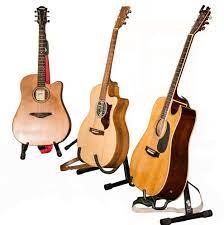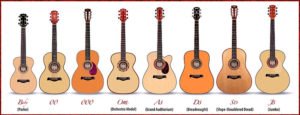The guitar is one of the most well-known instruments in the world; many aspiring musicians want to learn how to play this instrument.
The first step to learning is having a guitar to practice on, but not just any guitar will do.
One of the most crucial things you should consider is how comfortable you are with the instrument you’re using; therefore, the search for the perfect guitar is vital.
Guitars come in a variety of sizes and two of the most common ones are the standard full size and the smaller ¾ guitar.
How do full size guitars differ from ¾ guitars, and which one would suit you?
To help you decide, we made a full size versus ¾ guitar comparison.
Contents
The Primary Differences Between Full Size and ¾ Guitar

We can begin by looking at the differences between these guitar sizes:
- Dimension-wise, a full size is around 40×15 inches, whereas the smaller ¾ guitar is measured to be about 36×13 inches.
- When it comes to scale length, a full size is longer than 24 inches while a ¾ guitar has a scale length between 20 to 24 inches.
- A full size maintains string tension which keeps it in tune whereas a ¾ guitar doesn’t have a high string tension.
- A full size can cost thousands of dollars as opposed to a ¾ guitar which can be bought for less than a hundred dollars.
- Sound-wise, a full size creates a characteristic rich tone, in opposition to a ¾ guitar which often cannot reproduce said richness in tone.
As you can see, a full-size and a ¾ guitar may have a lot of differences but they also have a lot in common such as their shape, components, number of strings, and tuning process.
Crucial Details
Below are some important specifications to take into consideration when choosing between a full size and a ¾ guitar:
| Full Size Guitar | ¾ Guitar | |
| Body Material | Wood depends on the model | Wood depends on the model |
| Body Shape | Classical | ¾ Classical |
| Scale Length | 24 inches or more | 24 inches or less |
| Frets | 19 or more | 18 or less |
| Overall Size (approximation) | 40×15 inches | 36×13 inches |
| Warranty | Dependent on the manufacturer | Dependent on the manufacturer |
Review of the Different Characteristics of a Full Size vs a ¾ Guitar
Let’s dive in on what each of these guitar sizes has to offer.
Full-Size Guitar

Also known as the 4/4 guitar, the full size is thought by some to be the normal size of a guitar.
Except for headless guitars, electric guitars that have a built-in tuner instead of having a headstock connected to tuning pegs, most 4/4 guitar models are estimated to be about 40 inches in length.
Though it is tempting to immediately choose a guitar of this size, there are a lot of fundamentals that you need to examine before buying a full size that suits your height and playing style.
What makes a 4/4 guitar different from a ¾ guitar?
The Basics
To start off, here are features of this guitar size that you would want to consider:
- There is a choice on different bodies such as single, double, and non-cutaway
- Has a neck with more than 19 frets
- Has a scale length of more than 24 inches
- Most models measure at about 40×15 inches
- The materials (wood, plastic, metal, etc.) for making the body and the neck depends on the model and manufacturer
- The compatibility of the string gauge, thickness of the set of strings, depend on the guitar
- The cost can vary from hundreds of dollars to several hundred thousand dollars
Size and Shape
As it has been stated earlier the full-size measures around 40 inches long and 15 inches wide, fit for players who are 5 feet tall and above.
With a scale of more than 24 inches long, this guitar size has a more favorable string tension.
When it comes to the body, a 4/4 guitar has a similar appearance as a ¾ guitar as both may or may not have cutaways.
Pros and cons can be experienced due to this guitar size’s neck.
The pro is that it has a greater tonal versatility due to having more frets while the con is that it can be more difficult to reach the low notes especially if your fingers are on the short side.
While 4/4 guitars do have a characteristic sound, the sound the instrument produces depends on the material used in making the guitar; this is why the guitar model affects the sound properties.
For strings, you can choose a set that matches your guitar considering how a 4/4 guitar suits both nylon and steel strings with different gauges.
Sound
Even though the full-size guitar is less likely to become out of tune with its ability to retain string tension, you should make sure to give it a regular tune up so that its sound capabilities would be well-managed.
The full-size guitar’s sound essentially relies on its type as an acoustic guitar tends to sound different compared to a classical one.
This is also the case with the guitar’s strings wherein a guitar using steel strings sounds different to one with nylon strings.
A 4/4 guitar’s tonal properties can also be affected by its scale length.
The material used in making the guitar’s body (back, sides, and top) also influences its sound due to different materials having unique sound properties.
Other Notable Characteristics
It is important to note that in choosing a guitar of this size, the model’s features such as the tuning mechanism, bridge, and truss rod are worth looking into.
To be able to fully utilize the sound versatility of a full-size electric guitar, an amplifier is needed.
Any genre of music can be played on a full-size guitar.
The sound quality of your guitar is not solely based on its size, other features should always be taken into consideration.
Reliability
How much you can rely on your guitar is dependent on the manufacturer.
The materials used in making the guitar determines if it can endure heavy usage; but in a year or two, your guitar’s key parts would not have fallen apart.
Most guitars of this size survive years without coming apart; proper care of your guitar and preventing physical damage extends its life span.
¾ Guitar

This guitar size is fantastic for beginners, children around the ages of 8 to 12 years old, and those who are not tall.
It would be easier to learn guitar chords using a ¾ guitar as finger exercises would be effortless with less space to cover.
A ¾ guitar suits those between the age of 8 and 12 years old because it can be adjusted to their height.
As opposed to a full-size, adults who have difficulty reaching certain frets would find a ¾ guitar to be more appealing.
As a ¾ guitar and a full-size guitar have the same parts, the experience of playing a smaller guitar is similar to that of playing a full-size one.
Then, how are full-size and ¾ guitars different from one another?
The Basics
To kick things off, the following are important features of a ¾ guitar:
- This guitar size is mostly used for practice by beginners
- The body of most ¾ guitars are mahogany
- Rosewood, maple, or okume are some of the materials that can be used for the neck
- Tuning pegs are housed in a ¾ guitar’s headstock
- The scale length is measured to be about 20 to 24 inches
- The neck has 18 or less frets
- Regular nylon string sets can be used for this guitar size
Size and Shape
Generally, a ¾ guitar does not exceed 36 inches in length but its exact measurement depends on its model.
The width of this guitar size, estimated to be about 13 inches, is very important as those that are wider cannot be considered as ¾ guitar.
Differentiating between a full size and a ¾ guitar can be difficult because there isn’t much of a difference when comparing the body shape of the two guitar sizes.
Of course, the ¾ is smaller than the full size.
As was mentioned previously, the ¾ has a shorter scale length which affects how easy it is to press and bend strings due to less tension in the strings.
I should point out that even though a ¾ guitar is easier to play, it would not sound as good as a full-size guitar because tone and playability depends on the scale length of a guitar.
Sound
A considerable downside to having a ¾ guitar is that it tends to become out of tune more easily due to its laxer strings.
This means that you may need to tune your guitar as often as every hour.
What happens is that you may bend strings without meaning to, changing how a power chord or even other chords sound.
As this guitar size is primarily thought of as a practice guitar, the sound is forgone in favor of playability; a ¾ guitar is not hard on your hands and fingertips but it is not ideal for live performances.
In addition to that, your instrument’s sound also depends on the guitar strings you choose.
Before settling on a string set, you should test several different gauges and choose the set you think sounds best.
An overlooked advantage of a ¾ guitar is that it is wonderful for impromptu gatherings or casual jam sessions due to its capability of playing a variety of genres from pop to classic.
Its versatility is another reason why it is great for beginners.
Other Notable Characteristics
Having similar parts to a full-size guitar, it becomes easier to examine a ¾ guitar’s neck, body, and other parts to figure out which parts can be improved in terms of playability.
Since you will frequently use it, the tuning mechanism should be one of the things you look at.
Capos, guitar picks, and a tuner are guitar accessories worth getting.
It is also worth mentioning that appropriate care is essential for this guitar size because it can quickly fall into disrepair seeing as it is less durable.
Reliability
Let’s see if a ¾ guitar can go head-to-head with a full-size guitar when it comes to reliability.
When it comes to choosing a manufacturer for this guitar size, respected brands such as Gibson, Ibanez, Fender, and a lot of others offer different models of ¾ guitars that range from acoustic to electric.
¾ guitars would not lose to full-size ones when it comes to quality as a guitar of this size is made with the highest standards when manufactured by any dependable instrument-making brand.
This solidifies ¾ guitars as a great choice for those who have been uncertain due to perceived differences in quality.
How often you use your guitar as well as how you tend to it affects the lifespan of your guitar.
Remember not to spend too much on a ¾ guitar if you are a beginner and you intend to swap out your ¾ guitar to a full-size one when you become more experienced.
Comparing Full Size and ¾ Guitar – The Pros and Cons

Below is a comprehensive list of the pros and cons of each guitar size for easy perusal.
Full Size Guitar Pros
- Manufactured using materials with excellent quality
- Perfect for practicing and performing
- Less frequent tuning because of its high string tension
- Produces lush and outstanding sound
Full Size Guitar Cons
- May be too hefty for children below the age of 12 and petite adults with slight hands
- Tends to be on the pricier end
¾ Guitar Pros
- Made by some of the most trusted guitar-making brands
- Fit for training and for when you’re on the move
- Requires less effort to press and practice chords due to low string tension
- More economical and within your budget
¾ Guitar Cons
- Needs to be tuned more often; easily goes out of tune
- The short scale length tampers with the tonal properties of a guitar with this size
More Options Other Than Full Size and ¾ Guitars

If you think neither a full size nor a ¾ guitar may not be for you, there are a lot of other guitar sizes you could consider.
A ¾ guitar could still be too big for a child, especially those younger than 12 years old, when they’re starting to learn how to play a guitar.
The following is a collection of more guitar sizes that could be a better choice not only for children but also for adults and teenagers.
The Parlor Guitar
When progressing from a ¾ guitar to a dreadnought guitar, you may find the transition to be jarring.
To adapt better, you may want to try using a parlor guitar.
With the use of a parlor guitar, the increase in size of the instrument you’re playing becomes more gradual due to it being less grand and weighty compared to a jumbo or dreadnought guitar.
Even though a parlor guitar is classified as a 4/4 guitar, its weight and largeness aren’t as intimidating as that of the other full guitars.
Like other full-size guitars, your choice of strings on a parlor guitar fine-tunes the highs, lows, and overall sound of your guitar.
It is worth mentioning that this guitar size favors mid-range tones as opposed to basses.
Another important fact about the parlor guitar is that it usually has 18 frets on its neck which makes it a great layover when going from a ¾ guitar to a dreadnought one.
Half Size Guitar
Known to some as “halfie”, this guitar size is not likely to be difficult to find because almost all the leading guitar manufacturers create a half size version of their guitar models like those of their acoustic and electric guitars.
The reason it’s called half size is due to the guitar measurements being around 20 inches long and 8 inches wide, which is half the size of a 4/4 or full-size guitar.
For younger children who want to learn how to play the guitar, this would be a fantastic choice.
One downside to this guitar size is that it will easily be outgrown by its owners as this can quickly be too small for children to play.
An advantage to having a guitar of this size is it helps children learn how to tune their own guitar early on because it’s equipped with its own tuning mechanism.
Because it can only be used by a child for more than a few years, you should remember not to spend too much on a half size guitar.
¼ Guitar
Being the smallest sized guitar for kids, the ¼ guitar is great for children around 3 to 5 years old.
It is usually about 20% shorter than a full guitar, being around 19 inches long.
Even with it being small, you can still choose to have an acoustic or an electric model of this size.
A great thing about a ¼ guitar is that it is just wide enough so that you can still practice the conventional chords.
This is fantastic for learning the basics in playing a guitar but after a while, it needs to be exchanged for a larger guitar to properly develop a child’s playing skills.
This guitar size is usually compared to the ukulele.
Even though a ¼ guitar is a little bigger than a ukulele, the two instruments sound similar to one another.
This is because both create a lot of treble.
It is important to note that most children below 3 years old are not ready for real guitars which means that even with its size, a ¼ guitar is not for toddlers.
Frequently Asked Questions on Full Size and ¾ Guitars
These are some of the questions asked a lot when it comes to choosing a guitar:
Question: Do ¾ guitars cost a lot?
Answer: Similar to a full-size guitar, a ¾ guitar’s price depends on its model; some ¾ guitars cost around a hundred dollars while the upscale ones are of course pricier.
Question: Can ¾ guitars be used for live performances?
Answer: Yes, a ¾ guitar can be used for performing even though it is primarily designed to be for practice; what’s important is not what guitar you use when performing but how well you play your guitar.
Question: When is the best time to transition from a ¾ guitar to a full-size?
Answer: There are no hard and fast rules when it comes to transitioning between guitar sizes; even though full-sized guitars are advised for teenagers and adults, there is no age restriction when it comes to using guitars with smaller sizes.
Question: What type of full-size guitar should I choose? Acoustic or electric?
Answer: Choose a guitar that suits the genre of music you want to play; generally, guitarists master the acoustic guitar before progressing to the electric guitar as that would give more time to hone and refine guitar playing skills.
The Ruling: Is the Full Size Better Than the ¾ Guitar?
There isn’t really a clear answer on which guitar size is better overall.
One of the best ways to determine what size of guitar a player should get, is of course the guitarist’s height.
Those who stand below 5 feet, whether they’re children or adults, would find it easier to handle a ¾ guitar.
On the flip side, it is usually a more pleasant experience for guitarists taller than 5 feet to use full-sized guitars.
That being said, the size of your guitar should still depend on which one you are more comfortable with; nothing and no one is stopping you from using a different sized guitar as long as you enjoy playing it.
That ends this comparison between a full-sized guitar and a ¾ guitar.
Hopefully, you were able to find out more about the guitar and what size would suit you best.
Let us know which size of guitar you think fits you by commenting; you can also leave other questions, comments, and suggestions.
It would be great to hear from you!
